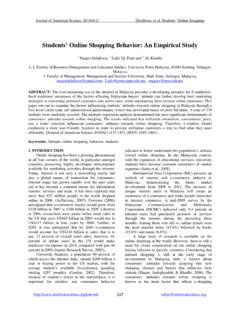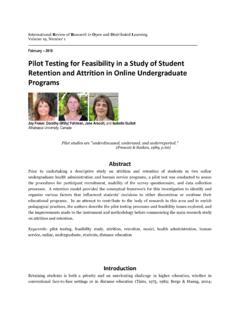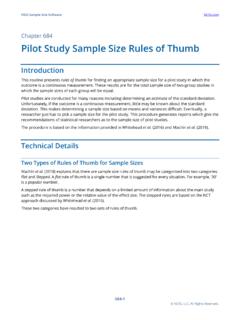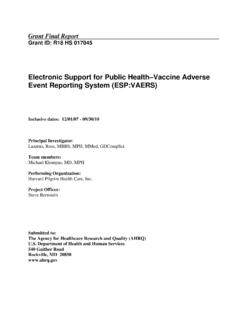Transcription of Journal of American Science 2019; 15(4) http://www ...
1 Journal of American Science 2019; 15(4) 17 Pharmacologic vitreolysis of vitreous floaters by 3-month pineapple supplement in Taiwan: A pilot study Chi Ting Horng1,2,4, Fu An Chen1,4, Daih Huang Kuo1, Li Chai Chen1, Shou Shan Yeh3, and Po Chuen Shieh1,* 1 Department of Pharmacy, Tajen University, Pingtung, Taiwan, ROC. 2 Departmet of Opthalmolgy, Fooying University Hospital, Pingtung, Taiwan, ROC. 3 Kaohsiung City Government, Kaohsiung, Taiwan, ROC. 4 These authors contributed equally to the paper. * Corresponding author: Po Chuen Shieh ; E mail: Abstract: Purpose: This survey is the first one in the world to evaluate the pharmacologic effects of pineapples for floaters. In different designs, we followed the results of patients who took various doses of pineapples each day for 3 months.
2 Methods: The studies and sources of crude pineapples were all scheduled between March and June 2016 in Southern Taiwan, including Tainan, Kaohsiung and Ping Tung Cities. The famous, beneficial and delicious pineapples were supplied by the local farmers selling to the world since 1900. In this study , 388 participants were arranged to undergo a series of ocular examinations during the series of experiments. In experiment 1, 190 subjects were classified into group 1 (one floater) and group 2 (multiple floaters); all participants took 2 pieces of pineapple after lunch every day for 3 months. In experiment 2, the 198 eyes with various vitreous floaters were classified into 3 groups by chance, according to the extent of pineapple intake, including the low pineapple group (LPA), middle pineapple group (MPA) and high pineapple group (HPA).
3 In all the experiments, our staff members cut into one piece of pineapple with 100 g. Regular intake of pineapples is good for health promotion and even cancer prevention; however, to prevent higher blood glucose and ensure daily caloric restriction, the reasonable amount of pineapple is 2 3 pieces within healthy persons. In experiment 2, the amounts of oral pineapples in LPA, MPA, and HMP were 1, 2, and 3 pieces after lunch each day, respectively. Results: In experiment 1,100% subjects of one floater (120 eyes) subsides to only (35/120) after 3 month therapy. Besides, 70 participants with multiple floaters decreased to 19 cases ( ; 19/70) three months later. In a world, the extract pineapple may enhance floaters disappearance.
4 In experiment 2, groups 1 3, (each group = 66 eyes) were choose randomly to different supplements including the LAP, MAP and HAP intake also for 3 months. It is surprised that from pineapple may increase the rate of disappearance of vitreous opacity. The percentage of decrease of floaters by taking the pineapples was , and and 1, 2, 3 pieces, respectively. It also showed that pineapples for treating the patients with floaters with dose dependent manner. In addition, the protocols for therapy of the floaters were no special side effects. Furthermore, the mechanisms of dissolving floaters may be to cut and clear the vitreous fibrils and to scavenge the free radicals which could result in hyaluronic acid degradation and vitreous floater formation.
5 Conclusion: We found that taking pineapples should diminish the persistence of floaters, posterior vitreous detachment and even extracellular matrixes which could impact the disturbance of vision and even associated complications. [Chi Ting Horng, Fu An Chen, Daih Huang Kuo, Li Chai Chen, Shou Shan Yeh, and Po Chuen Shieh. Pharmacologic vitreolysis of vitreous floaters by 3-month pineapple supplement in Taiwan: A pilot study . J Am Sci 2019; 15(4):17 30]. ISSN 1545 1003 (print); ISSN 2375 7264 (online). 3. Keywords: pineapple, vitreous floater, bromelain Introduction The vitreous is highly hydrated gel like structure (> 98% water) that is acellular, apart from a few cells called hyalocytes in the vitreous cortex. Besides, the gel state is maintained by a network of long thin collagen fibrils that are approximately 15 nm in diameter.
6 Filling the space is a network of hyaluronan; this glycosaminoglycan (polysaccharide) may attract water and generate swelling pressure that inflates the gel. The collagen fibrils are composed of collagen type II, V, XI and IX. They are organized into small bundles, and interconnections between these bundles allow the formation of an extended network that maintains the gel state. During aging, the vitreous progressively liquefies and pockets of liquid form in the gel. In the adult eye, 20% of vitreous is liquid, then after the age of 40 years there is increasing liquefaction so that by 80 to 90 years of age more than half of vitreous is liquid (1). The vitreous liquefaction, in conjunction with age related weakening of postbasal vitreous retinal adhesion, then results in posterior Journal of American Science 2019; 15(4) 18 vitreous detachment (PVD).
7 In clinics, the symptom of PVD is the most common cause of acute onset floaters. A recent paper by van Overdam and his co workers suggests that patients with isolated PVD, vitreous floaters, vitreous hemorrhages or retinal hemorrhages at initial presentation need to be rescheduled for a follow up visit (2). All the persons were instructed to return if the number of floaters increased. However, the majority of PVD is benign regarding physiological change. For those older than 40 years of age, PVD gradually impacts the visual axis. Moreover, the prevalence of PVD is up to 24% among those aged 50 59 years, increasing to 87% among people older than 80 years. In PVD, the vitreous shrinks and detaches from the retina, leading to floaters.
8 In 14% of cases, tractional forces from the vitreous jelly over the retina sometimes cause retinal tears. However, left untreated, the tears which result in breakage may allow fluid to enter the sub retinal space and could progress to retinal detachment (RD) and even blindness. Therefore, wiping out vitreous floaters early is very important for eyesight preservation (3). Physiologically, the vitreous requires a complex biochemical and structural procedure. It is completely attached to the retina. Floaters usually begin as a few small spots, curtains and clouds, becoming much denser over time. In most cases, vitreous opacities occur as a result of degenerative changes. The vitreous liquefaction should provoke condensation of vitreous collagen fibers and PVD which show floaters.
9 In a more dramatic condition, the existence of floaters is induced. In humans, most ocular floaters are small flecks of a protein called collagen in the back of your eye. As you age, the protein fibers that make up the vitreous shrink down to little shreds that clump together. The shadows they cast on your retina are floaters. If you further see a flash, it s because the vitreous has pulled away from the retina. Besides, posterior uveitis or bleeding in the eye is another reason for ocular floaters, which is a serious condition of the eyes (4). At times, the symptoms of floaters may occur when patients suffer from high fever, head injuries or influenza at times and the troublesome problem should recover spontaneously after two weeks.
10 However, after aged 40, the vitreous gel should begin to liquefy involving nearly 50% by age 80, a process called synchysis. When the lysis forms, the posterior scaffold should detach from the retina with the intervening space (5). Generally speaking, monocular floaters in patients often reflect some underlying ocular disease. For example, the major causes of monocular floaters include: PVD, vitreomacular traction (VMT) and vitreous hemorrhage. Additionally, although less likely, monocular causes of floaters also include Endophthalmitis, uveitis, vitreous lymphoma, and retinal degeneration. According to past studies, the relationship between ocular floaters and PVD is a close one. The presence of complete PVD is highly associated with symptomatic vitreous floaters.








